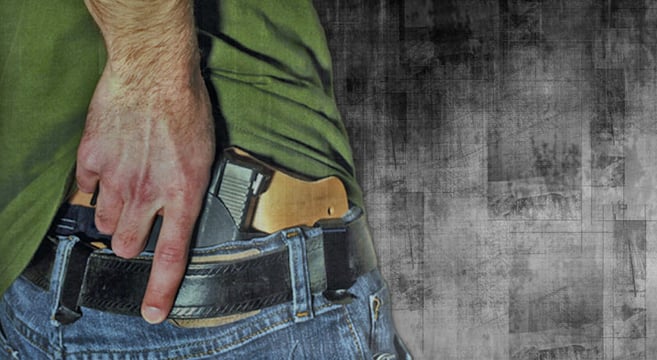Once your concealed carry firearm has left its holster, you’re committed. Right or wrong, legal or not, it’s out and about in public where it shouldn’t normally be. You may as well ensure that before you re-holster, the situation is safe to do so.
How does one assess this? Generally speaking, we’re going to go over a few different examples to illustrate where the lines are a bit clearer.
1. You’ve Just Completed A Self-Defense Shooting
This means you’ve taken out your pistol, discharged it at an attacker, and now are no longer being attacked.
Answer the following questions as best as you can:
- Do you know for certain that attacker was alone?
- Have your attacker’s firearms/weapons been secured?
If both of these questions are ‘yes’, standby for police. Keep your firearm pointed in a safe direction. Follow their commands precisely when they arrive.
If any of those above answers are ‘no’, maintain cover and concealment. Do not stand out in the open and wait for other opponents to present themselves. Advise others to do the same.
Take a look at what our friend Aaron did when he successfully stopped a brutal assault. He kept his firearm on the subject until police arrived and at that time, followed the officer’s orders. No one was injured and everyone went home at the end of the day.
2. Pulled Firearm In Self-Defense But Did Not Use It
It’s always advised that you never draw your self-defense pistol unless you have clear intention of using it to preserve the life of yourself, your family, or your property. That said, if the pistol came out and the situation appeared to evaporate (your potential attackers retreated, etc.), assess the situation carefully.
- Are your attackers leaving to get their firearms and return?
- Has the situation de-escalated or is it about to take a turn for the worst?
Knowing the answers to those previous questions is really tough. If you’re wrong, you may be stuck in a much more dangerous situation. Conversely, if you’re wrong, you may be prone to over-escalating a situation. That’s the delicate part with self-defense – it has to be defense. You’re not allowed to go on the offense. So this vague restriction tends to put concealed carriers in a bind.
If police are en route, standby. Take a good defensive position, keep your firearm pointed in a safe direction, maintain situational awareness. Once police arrive, follow all lawful commands they issue – immediately.
Notice something about those two previous scenarios? Neither of them explicitly tell you to re-holster. Why? Because unless you can guarantee there is no further attack likely or imminent, that pistol is exactly where it needs to be – at the ready for your defense. In the rare instance (truly rare) you will ever be called upon to use your firearm for self-defense, don’t take any chances.
3. Self-Defense Event Takes Place, Police Have Not Yet Been Notified
Police aren’t likely to arrive in time to protect you. But, in most cases where a firearm is involved, they’ll likely be there eventually. In the odd circumstance that they aren’t – i.e. you’re wandering in the woods and encounter a situation – your first priority is to get to safety. You don’t need to re-holster then. You stay alert, head on a swivel, and get to a safe place before calling in the event.
If you’re in an exposed location where you feel threatened or have knowledge of an impending danger or threat, your first priority is to get to a secure location and notify law enforcement. Throughout this process, you may keep your firearm handy so long as it’s always pointed in a safe direction.
So, When Do You Re-Holster Your Concealed Carry Firearm?
You re-holster your concealed carry firearm once you are reasonably certain that the threat to your life has ended. Until then, keep it out and maintain tight situational awareness.
Things you can do while you’re waiting…
- Reload your pistol with your back-up magazine
- Secure firearms from your downed opponent(s)
- Call your attorney (highly recommended)
Disclaimer: The above are opinions of the author. In any situation dealing with self-defense, it is your responsibility to understand the laws in your area, and what you can and cannot legally do. It is also your responsibility to use your best judgement, given the situation that you may find yourself in. In no way should this information be viewed as legal advice. When in doubt, consult a lawyer for any clarification that you may require. Simply put, use your best judgement and always abide by the law.














